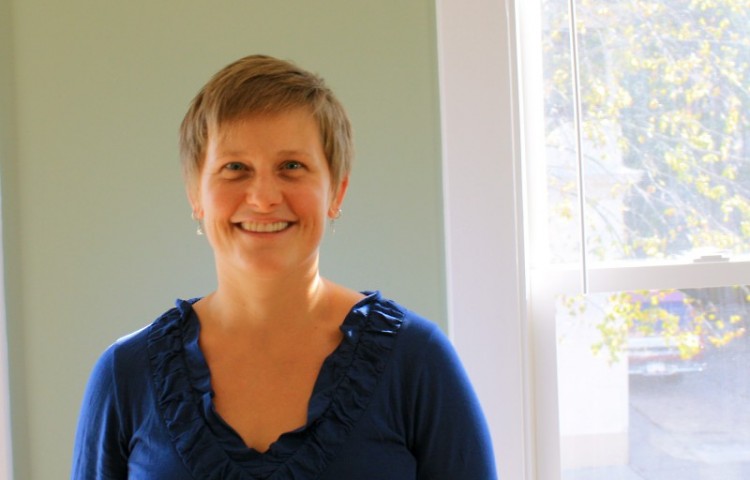When the owner of 946 Cherry bought the building in 1952, he probably never dreamed it would one day be used for things like Chinese energy therapy and brewing kombucha.
Grand Rapids already has many non-traditional health options—naturopathy, yoga, osteopathic hospitals—but Sarah Steger’s center is different. An extension of her SES for Health business, Steger’s Holistic Learning Center presents a mix of direct treatment services, learning opportunities and groups activities that empower clients to take a more active role in their own health and wellness.
“It’s about educating clients to make the best decisions for them,” says Steger, 35. “It’s not the medical professional—or the alternative health person—who should be making those choices. That is why I strive for education. Understanding your condition empowers you to overcome that condition.”
Along with seeing education as an important part of treatment, Steger works hard on another aspect: longterm affordability. She has worked hard to make her alternative health care more affordable for people by doing “a lot of work on the front end.” She offers free initial consultations and tries hard to keep class fees low.
“I try to keep classes extremely affordable so you have a chance to talk to the instructor and build a relationship,” says Steger. “I also usually email paperwork to people beforehand, which costs nothing. If they cancel their appointment, we’re not out anything.”
“If you decide to keep working with me, I always ask what your budget is,” she continues. “You need to have an honest conversation with yourself about what you can afford.”
Steger’s client, Beverly Whitaker, admits that alternative therapy, which is not covered by most insurance plans, requires a financial investment—something that took her husband a while to understand.
“My husband is a very conventional person as far as medicine and things like that,” says Whitaker, who lives in Kentwood. Though at first he was skeptical and quick to prescribe remedies like antacid or Ibuprofen, eventually Whitaker’s husband started to see results.
“Now he tells people: ‘Those essential oils she uses are helping her so much. She works really hard with those.’ And I, like, never thought that I would ever hear that from him. He doesn’t ask how much I spend any more and money’s a big thing for him.”
Steger started Holistic Learning Center “to draw the health and wellness community together,” but she doesn’t want her clients’ wellness to be dependent on taking classes and buying services.
“She isn’t a person who wants you to have to rely on your services to feel good. She wants you to learn how to help yourself.” Whitaker says about Steger. “That’s the whole basis on how Sarah has built her business.”
A new spin on some really old ideas
Ironically, a lot of the things that make Steger’s practice unique are actually centuries old.
Qigong—the “Chinese yoga” that spawned Tai Chi—predates the birth of Christ by about 500 years. Aromatherapy gained popularity in Europe in the 11th century. Ethnobotanists confirm medicinal plant use among the most ancient people groups all over the world.
In the United States, conventional medicine replaced the work of midwives and lay practitioners in the 19th century, demoting traditional healing techniques from America’s medicinal mainstream, despite their proven effectiveness. But as early as the 1830s, proponents of “popular health” were already organizing against state policy prohibiting its use by medical professionals.
Today, the existence of groups like the American Holistic Medical Association and certification programs for practitioners like Steger have increased the credibility of non-conventional interventions in patient care. But despite endorsements by the conventional medical community, many people still have misconceptions about holistic health, says Steger. She says holistic health can work with conventional methods, rather than patients ignoring conventional medicine altogether.
“People believe it is an alternative versus a complement,” says Steger. “[Conventional and holistic methods] can complement each other.”
In addition to more mainstream fare like yoga and strength training, Steger, a University of Michigan grad with a bachelor’s in Chinese language and literature, also gives instruction on aromatherapy, body systems, universal laws and chakras. Clients can also sign up for one-on-one treatment consultations and massage therapy services.
A leaf from Nature’s book
Clients who are used to instant and dramatic results from medical treatment may be skeptical of alternative healing.. Natural methods do not always deliver immediate, powerful relief, especially for patients who regularly use prescription drugs.
“When you stay on [prescription drugs] for a long time you’re changing your base point,” Steger explains. “We have to build up the dose to compete with the medicinal dose.”
Though flower essences and massage therapy may not pack quite the same punch as anti-depressants or narcotic painkillers, according to Steger’s client Beverly Whitaker they are quite effective with long-term use.
Whitaker, 49, began working with Steger after she was diagnosed with fibromyalgia—a condition characterized by chronic, body-wide pain and psychological side effects.
“Fibromyalgia is one of those things that pushes you into unconventional techniques because there aren’t good drugs for it out there,” says Whitaker, who has been working with Steger for over five years.
“We worked on getting my body to release the pain that I felt imprisoned by. And then that helped with the chronic fatigue.”
In addition to regular massage treatments, Steger introduced Whitaker to aromatherapy through essential oils, as well as infusions in water-based formulas that can be more easily absorbed.
“I’ve never been able to take vitamins. My body can’t break down all of that,” says Whitaker, referring to ingredients like binding agents used in pill supplements. “It worked so hard break them down to find the good stuff that I lost more energy than I gained.”
The hidden costs of health care
Energy conservation is an issue outside the body too. Pharmaceutical companies may be working to reduce their carbon footprints, but the industry still takes a great environmental toll because, says Steger, it continues to use “high heat, high force” manufacturing.
Steger believes that biomimicry—a field that explores production in nature—can help us develop lower impact solutions for both manufacturing and using medicine. She uses the clamshell as an example of an exceptionally durable, effective solution created through low impact means.
Unfortunately, the current health care system provides little incentive to adopt low impact production or consumption, according to Steger. She explains that insurance companies subsidize conventional treatments like a government subsidizing corn. True environmental costs and the long-term toll of protracted pharmaceutical use are eclipsed by the artificially low prices of drug co-pays and generics, she says.
“It’s our whole system,” Steger admits. “But you have to look at the total cost.”
The Rapidian, a program of the 501(c)3 nonprofit Community Media Center, relies on the community’s support to help cover the cost of training reporters and publishing content.
We need your help.
If each of our readers and content creators who values this community platform help support its creation and maintenance, The Rapidian can continue to educate and facilitate a conversation around issues for years to come.
Please support The Rapidian and make a contribution today.


